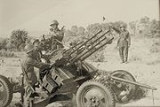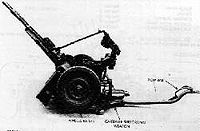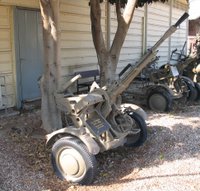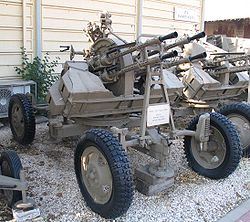
ZPU-4
Encyclopedia
The ZPU-4 is a towed, quadruple-barreled anti-aircraft gun based on the Soviet KPV
14.5 mm machine gun
. It entered service with the Soviet Union
in 1949 and is used by over 50 countries worldwide. Double- and single-barreled version of the weapon exist, called the ZPU-2 (two variants) and ZPU-1 respectively.
All weapons in the ZPU series have air-cooled quick-change barrels and can fire a variety of ammunition including API (B32), API (BS41), API-T (BZT) and I-T (ZP) projectiles. Each barrel has a maximum rate of fire of around 600 rounds per minute, though this is practically limited to about 150 rounds per minute.
The quad-barrel ZPU-4 uses a four-wheel carriage similar to that once used by the obsolete 25 mm automatic anti-aircraft gun M1940
. In firing position, the weapon is lowered onto firing jacks. It can be brought in and out of action in about 15 to 20 seconds, and can be fired with the wheels in the traveling position if needed.
The double-barrel ZPU-2 was built in two different versions; the early model has large mud guards and two wheels that are removed in the firing position, and the late model has wheels that fold and are raised from the ground in the firing position.
The single-barrel ZPU-1 is carried on a two-wheeled carriage and can be broken down into several 80-kilogram pieces for transport over rough ground.
Versions of the weapon are built in both China and North Korea.
by Chinese
and North Korea
n forces, and was later considered to be the most dangerous opposition to U.S. helicopter
s in Vietnam
. Later it was used by Morocco
and the Polisario Front
in the Western Sahara War
. It was also used by Iraq
i forces during Operation Desert Storm and again in Operation Iraqi Freedom.
In the Russian military, it was replaced by the newer and more powerful ZU-23 23 mm twin automatic anti-aircraft gun .
The type has seen widespread use by both sides in the 2011 Libyan civil war
often mounted on pickup trucks technicals
.

Rounds are also produced by Bulgaria
, China
, Egypt
, Poland
, and Romania
.



KPV heavy machine gun
The KPV-14.5 heavy machine gun is a Soviet designed 14.5x114mm-caliber heavy machine gun, which first entered service as an infantry weapon in 1949. In the 1960s the infantry version was taken out of production because it was too big and heavy...
14.5 mm machine gun
Machine gun
A machine gun is a fully automatic mounted or portable firearm, usually designed to fire rounds in quick succession from an ammunition belt or large-capacity magazine, typically at a rate of several hundred rounds per minute....
. It entered service with the Soviet Union
Soviet Union
The Soviet Union , officially the Union of Soviet Socialist Republics , was a constitutionally socialist state that existed in Eurasia between 1922 and 1991....
in 1949 and is used by over 50 countries worldwide. Double- and single-barreled version of the weapon exist, called the ZPU-2 (two variants) and ZPU-1 respectively.
Description
Development of the ZPU-2 and ZPU-4 began in 1945, with development of the ZPU-1 starting in 1947. All three were accepted into service in 1949. Improved optical predicting gunsights were developed for the system in the 1950s.All weapons in the ZPU series have air-cooled quick-change barrels and can fire a variety of ammunition including API (B32), API (BS41), API-T (BZT) and I-T (ZP) projectiles. Each barrel has a maximum rate of fire of around 600 rounds per minute, though this is practically limited to about 150 rounds per minute.
The quad-barrel ZPU-4 uses a four-wheel carriage similar to that once used by the obsolete 25 mm automatic anti-aircraft gun M1940
25 mm automatic air defense gun M1940 (72-K)
25 mm automatic air defense gun M1940 was a Soviet 25 mm caliber anti-aircraft gun. The gun was created in the beginning of 1940 at 8th Kalinin Artillery Plant in Kaliningrad under the guidance of its Chief Designer Mikhail Loginov....
. In firing position, the weapon is lowered onto firing jacks. It can be brought in and out of action in about 15 to 20 seconds, and can be fired with the wheels in the traveling position if needed.
The double-barrel ZPU-2 was built in two different versions; the early model has large mud guards and two wheels that are removed in the firing position, and the late model has wheels that fold and are raised from the ground in the firing position.
The single-barrel ZPU-1 is carried on a two-wheeled carriage and can be broken down into several 80-kilogram pieces for transport over rough ground.
Versions of the weapon are built in both China and North Korea.
History
The series was used during the Korean WarKorean War
The Korean War was a conventional war between South Korea, supported by the United Nations, and North Korea, supported by the People's Republic of China , with military material aid from the Soviet Union...
by Chinese
China
Chinese civilization may refer to:* China for more general discussion of the country.* Chinese culture* Greater China, the transnational community of ethnic Chinese.* History of China* Sinosphere, the area historically affected by Chinese culture...
and North Korea
North Korea
The Democratic People’s Republic of Korea , , is a country in East Asia, occupying the northern half of the Korean Peninsula. Its capital and largest city is Pyongyang. The Korean Demilitarized Zone serves as the buffer zone between North Korea and South Korea...
n forces, and was later considered to be the most dangerous opposition to U.S. helicopter
Helicopter
A helicopter is a type of rotorcraft in which lift and thrust are supplied by one or more engine-driven rotors. This allows the helicopter to take off and land vertically, to hover, and to fly forwards, backwards, and laterally...
s in Vietnam
Vietnam
Vietnam – sometimes spelled Viet Nam , officially the Socialist Republic of Vietnam – is the easternmost country on the Indochina Peninsula in Southeast Asia. It is bordered by China to the north, Laos to the northwest, Cambodia to the southwest, and the South China Sea –...
. Later it was used by Morocco
Morocco
Morocco , officially the Kingdom of Morocco , is a country located in North Africa. It has a population of more than 32 million and an area of 710,850 km², and also primarily administers the disputed region of the Western Sahara...
and the Polisario Front
Polisario Front
The POLISARIO, Polisario Front, or Frente Polisario, from the Spanish abbreviation of Frente Popular de Liberación de Saguía el Hamra y Río de Oro is a Sahrawi rebel national liberation movement working for the independence of Western Sahara from Morocco...
in the Western Sahara War
Western Sahara War
The Western Sahara War was an armed conflict primarily between the Polisario Front and Morocco, the conflict erupted after the withdrawal of Spain from the Spanish Sahara in accordance with the Madrid Accords by which it gave administrative control of the territory to Morocco and Mauritania...
. It was also used by Iraq
Iraq
Iraq ; officially the Republic of Iraq is a country in Western Asia spanning most of the northwestern end of the Zagros mountain range, the eastern part of the Syrian Desert and the northern part of the Arabian Desert....
i forces during Operation Desert Storm and again in Operation Iraqi Freedom.
In the Russian military, it was replaced by the newer and more powerful ZU-23 23 mm twin automatic anti-aircraft gun .
The type has seen widespread use by both sides in the 2011 Libyan civil war
2011 Libyan civil war
The 2011 Libyan civil war was an armed conflict in the North African state of Libya, fought between forces loyal to Colonel Muammar Gaddafi and those seeking to oust his government. The war was preceded by protests in Benghazi beginning on 15 February 2011, which led to clashes with security...
often mounted on pickup trucks technicals
Technicals
Technicals may be:* Technical , an improvised fighting vehicle often used in civil conflict* TECHNICALS, a clothing brand owned by Blacks Leisure Group...
.
Ammunition

- API (BS.41) - Full metal jacket bulletFull metal jacket bulletA full metal jacket is a bullet consisting of a soft core encased in a shell of harder metal, such as gilding metal, cupronickel or less commonly a steel alloy. This shell can extend around all of the bullet, or often just the front and sides with the rear left as exposed lead...
round with a tungsten carbideTungsten carbideTungsten carbide is an inorganic chemical compound containing equal parts of tungsten and carbon atoms. Colloquially, tungsten carbide is often simply called carbide. In its most basic form, it is a fine gray powder, but it can be pressed and formed into shapes for use in industrial machinery,...
core. Projectile weight is 64.4 g (2.27 oz) and muzzle velocityMuzzle velocityMuzzle velocity is the speed a projectile has at the moment it leaves the muzzle of the gun. Muzzle velocities range from approximately to in black powder muskets , to more than in modern rifles with high-performance cartridges such as the .220 Swift and .204 Ruger, all the way to for tank guns...
is 976 m/s (3,202 ft/s). Armor-penetration at 500 m (547 yds) is 32 mm (1.25 in) of RHARolled homogeneous armourRolled homogeneous armour is a type of steel which is used to armour vehicles.-Composition:Armoured steel must be hard yet impervious to shock in order to resist high velocity metal projectiles. Steel with these characteristics is produced by processing cast steel billets of appropriate size and...
at 90 degrees. - API-T (BZT) - Full metal jacket round with a steel core. Projectile weight is 59.56 g (2.10 oz) and muzzle velocity is 1,005 m/s (3,297 ft/s). Tracer burns to at least 2,000 m (2,187 yds).
- I-T (ZP) - Projectile weight is 59.68 g (2.10 oz).
Rounds are also produced by Bulgaria
Bulgaria
Bulgaria , officially the Republic of Bulgaria , is a parliamentary democracy within a unitary constitutional republic in Southeast Europe. The country borders Romania to the north, Serbia and Macedonia to the west, Greece and Turkey to the south, as well as the Black Sea to the east...
, China
China
Chinese civilization may refer to:* China for more general discussion of the country.* Chinese culture* Greater China, the transnational community of ethnic Chinese.* History of China* Sinosphere, the area historically affected by Chinese culture...
, Egypt
Egypt
Egypt , officially the Arab Republic of Egypt, Arabic: , is a country mainly in North Africa, with the Sinai Peninsula forming a land bridge in Southwest Asia. Egypt is thus a transcontinental country, and a major power in Africa, the Mediterranean Basin, the Middle East and the Muslim world...
, Poland
Poland
Poland , officially the Republic of Poland , is a country in Central Europe bordered by Germany to the west; the Czech Republic and Slovakia to the south; Ukraine, Belarus and Lithuania to the east; and the Baltic Sea and Kaliningrad Oblast, a Russian exclave, to the north...
, and Romania
Romania
Romania is a country located at the crossroads of Central and Southeastern Europe, on the Lower Danube, within and outside the Carpathian arch, bordering on the Black Sea...
.
Variants

- ZPU-4
- Type 56 - Chinese-built version.
- ZPU-2
- Type 58 - Chinese-built version.
- ZPU-1
- BTR-40A SPAAG - A BTR-40BTR-40The BTR-40 is a Soviet non-amphibious, wheeled armoured personnel carrier and reconnaissance vehicle. It is often referred to as the Sorokovka in Soviet service. It is also the first mass-produced Soviet APC...
APC with a ZPU-2 gun mounted in the rear. Entered service in 1950. - BTR-152A SPAAG - A BTR-152BTR-152The BTR-152 was a non-amphibious Soviet wheeled armored personnel carrier that entered Soviet service in 1950. By the early 1970s it had been replaced in the infantry vehicle role by the BTR-60...
with a ZPU-2 mounted in the rear. Entered service in 1952.
Specifications


| Model | ZPU-1 | ZPU-2 (early) | ZPU-2 (late) | ZPU-4 |
|---|---|---|---|---|
| Barrels | 1 | 2 | 2 | 4 |
| Weight (travelling) | 413 kg (910 lb) |
994 kg (2,191 lb) |
649 kg (1,430 lb) |
1,810 kg (3,990 lb) |
| Weight (firing) | 413 kg (910 lb) |
639 kg (1,408 lb) |
621 kg (1,369 lb) |
1,810 kg (3,990 lb) |
| Length (travel) | 3.44 m (11.28 ft) |
3.54 m (11.61 ft) |
3.87 m (12.69 ft) |
4.53 m (14.86 ft) |
| Width (travel) | 1.62 m (5.31 ft) |
1.92 m (6.29 ft) |
1.37 m (4.49 ft) |
1.72 m (5.64 ft) |
| Height (travel) | 1.34 m (4.39 ft) |
1.83 m (6.00 ft) |
1.1 m (3.60 ft) |
2.13 m (7 ft) |
| Elevation | +88/-8 | +90/-7 | +85/-15 | +90/-10 |
| Traverse | 360 | |||
| Maximum range | 8,000 m (8,749 yds) |
|||
| Maximum altitude | 5,000 m (16,404 ft) |
|||
| Effective altitude | 1,400 m (4,593 ft) |
|||
| Ammunition (rounds) | 1200 | 2400 | 4800 | |
| Crew | 4 | 5 | ||
Operators
-
 Kosovo Liberation ArmyKosovo Liberation ArmyThe Kosovo Liberation Army or KLA was a Kosovar Albanian paramilitary organization which sought the separation of Kosovo from Federal Republic of Yugoslavia in the 1990s....
Kosovo Liberation ArmyKosovo Liberation ArmyThe Kosovo Liberation Army or KLA was a Kosovar Albanian paramilitary organization which sought the separation of Kosovo from Federal Republic of Yugoslavia in the 1990s....
? Libyan People's Army

